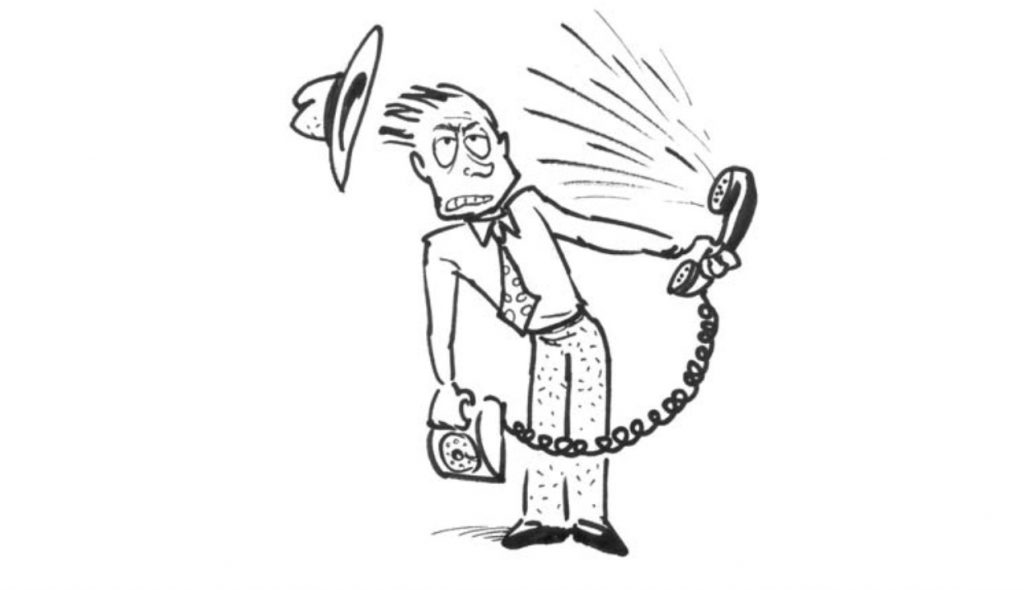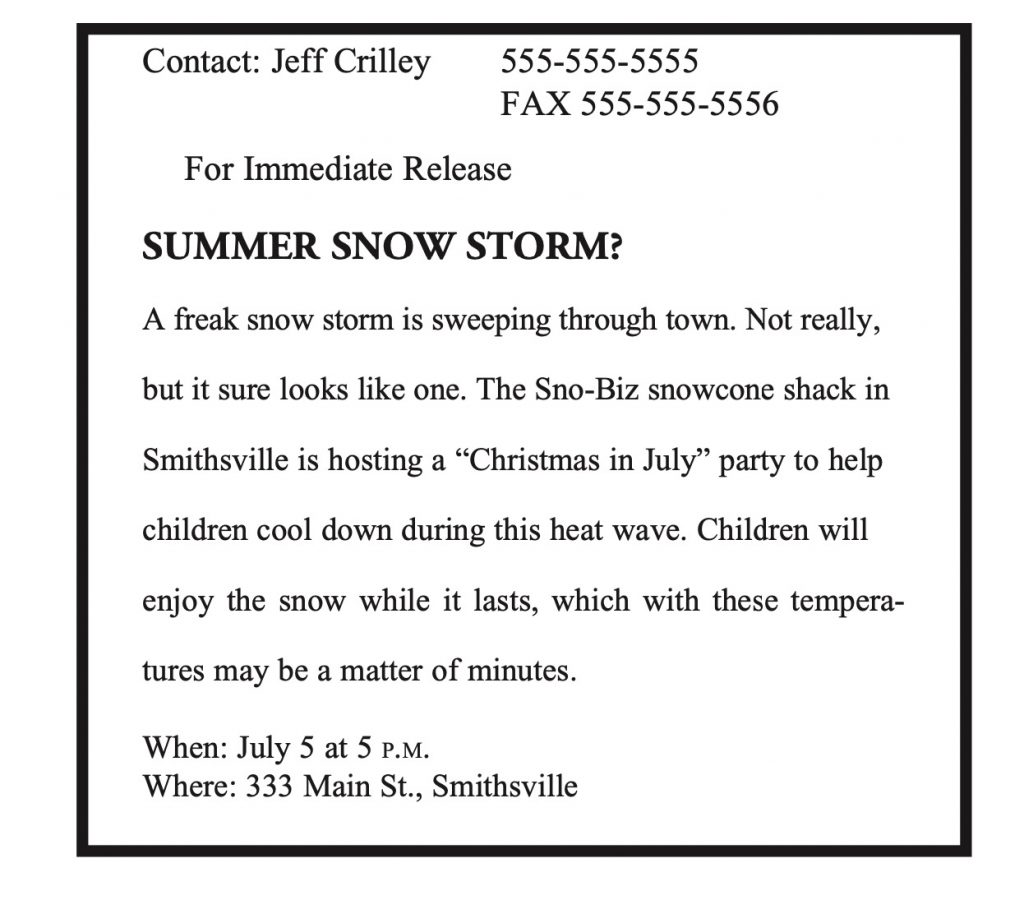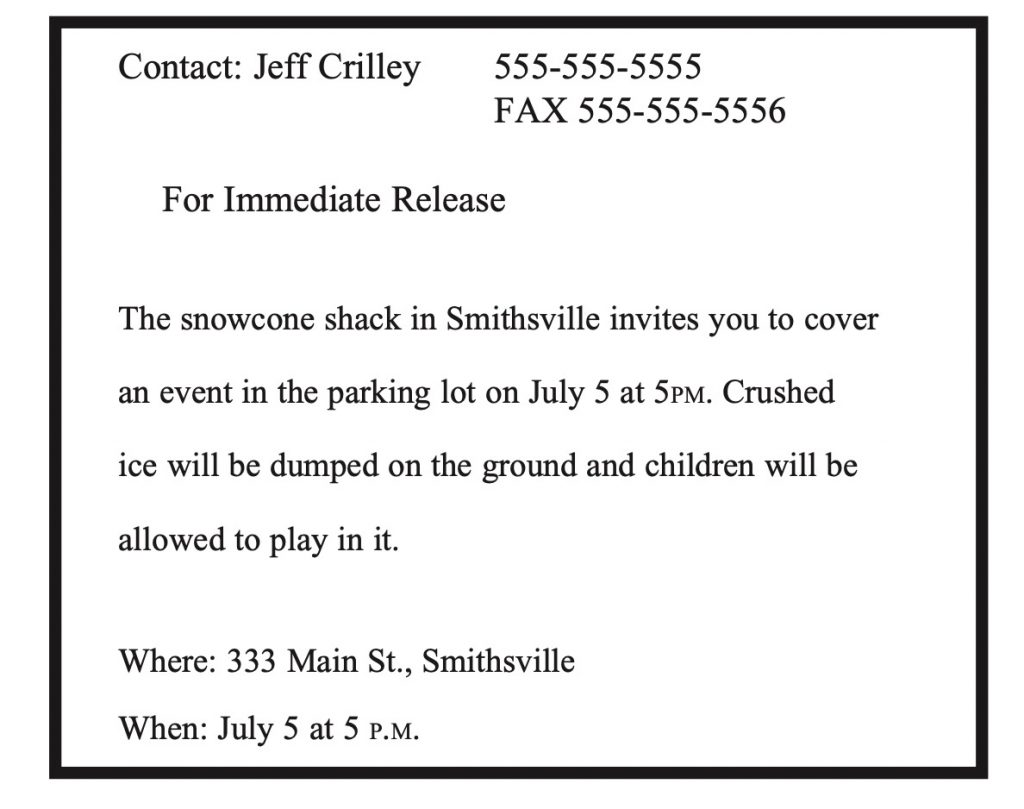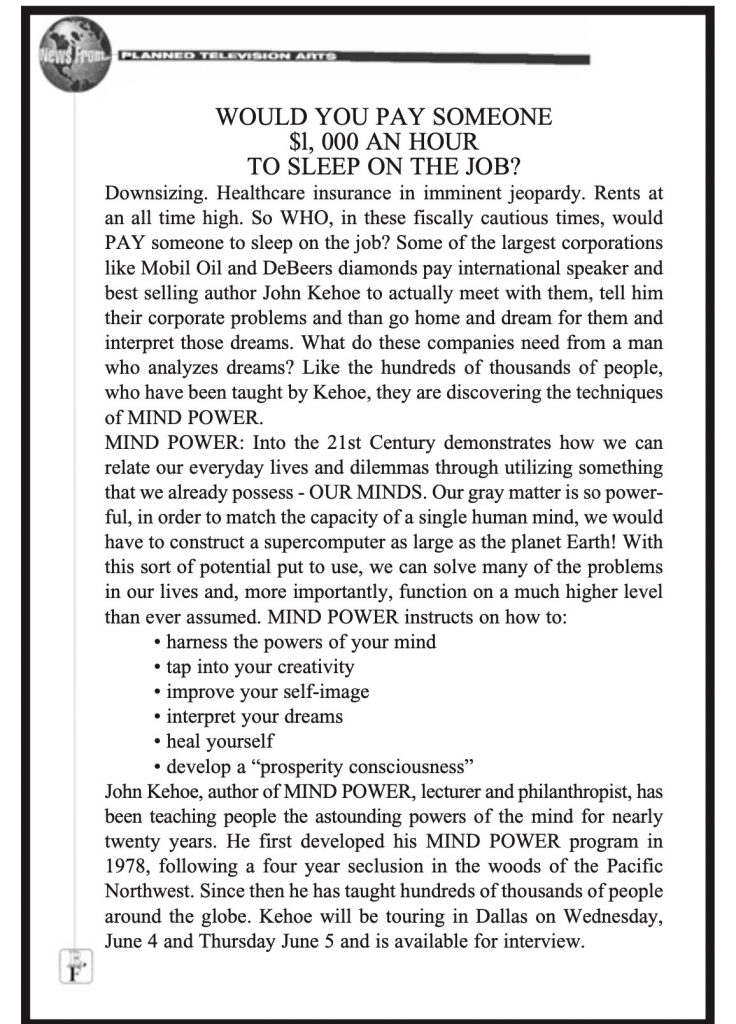WHO YA GONNA CALL?
Okay, so now you’ve come up with your own Elvis turkey story. You’ve thought out the visuals. You’ve tried to take advantage of the feeding frenzy, and you’re ready for the media to beat a path to your door. Now, at the risk of ripping off the Ghostbusters, “Who ya gonna call?”
One of the great mysteries of the news universe seems to be how to get our attention. I’ll admit, it’s not always easy. Our newsroom gets hundreds of phone calls, faxes, and e-mails every day from people pitching stories. So how do you separate yourself from the rest?
The first thing you should do is become familiar with the people who would likely cover your story. Does the station have a certain reporter who concentrates on just business stories? Or is there someone who tends to cover the lighter stuff? Watch the news and take notes. Who covers what?
For instance, when Shaun had his Elvis sighting in the barnyard, he was lucky he happened to call me. At the time, I had been assigned to cover nothing but “leave ’em laughing” stories, so Elvis and I were birds of a feather. But had Shaun called our investigative reporter, that would have been a fowl, to say the least.
The same holds true of most newspapers. Some reporters cover “crime and courts” and others “human interest.” There are literally dozens of beats reporters can have—politics, health, business, religion, science, technology, consumer, and entertainment. So do your homework. Know which reporters specialize in the types of stories you want covered.
Where do I start? At the back of the book, I’ve included the Web sites for hundreds of TV stations across the country. Through each station’s site, you should be able to read more about each reporter and determine which one is best suited to cover your story. Most sites will also have phone numbers, fax numbers, and e-mail addresses for individual reporters.
THE WINDUP AND THE PITCH
I love it when someone calls me to pitch a story and is already familiar with my work. If a phone call begins, “Jeff, first let me say how much I enjoyed that Elvis turkey story you had on last week,” I’m going to be more receptive to whatever is said next. Sure, I know I’m being buttered up, but it still works.
What the caller has communicated in the first few seconds is: “I watch your news,” and “I’m a fan of your work.”
Believe me, I’ve had many calls that begin, “Now what is it you do again? Are you on TV or behind the scenes?” Journalists have egos just like anyone else. Whether in print, radio, or TV, we’d all like to believe that everyone knows who we are and what we do.
So now that you’ve stroked our egos, what next? Well, often we are on deadline. So if we pick up the phone at all, that’s a good sign. But don’t assume just because you’re talking to us that we have time to chat. Cut to the chase. Sum up your story in one sentence.
If I were the one pitching the story to a reporter, I’d come up with something catchy. I’d describe the story the same way an anchor would introduce it on the air.
PUTTING ON THE DOG
Laila Ferrell really knows how to sell a story. She runs an upscale kennel, which she calls a pet bed and breakfast. So when Laila wanted me to come out and give her some free publicity she pretty much wrote my opening line for me. “Jeff, you do such cute features. Why don’t you come out and cover my kennel for pampered pets? It’s the Ritz Carlton for canines!” Then she quickly described the visuals. (Let us know what the pictures are going to be once we get there.)
She told me each six by six-foot cage is completely furnished with miniature sofas, fake fireplaces, even tiny TVs. “You’ve got to see it,” she said excitedly. “These doggie digs are more posh than some people’s houses.”
Laila threw the perfect pitch. She complimented me on my work. She described the visuals. And she sold me with her “Ritz Carlton for canines” comparison. Now that’s good writing! She came up with a better opening line for the report than I ever could.
VOICEMAIL
Leaving a message can be a good thing as long as it’s short. If it’s any longer than thirty seconds I know reporters who will automatically delete you.
Practice making a thirty-second pitch before you call us. Start with your name and number. Then sum up your story in one sentence. And you may want to repeat your number again at the end.
But no matter what you do, please say your number s-l-o-w-l-y. My wife, Victoria Snee, is a TV entertainment reporter. She says inaudible phone numbers are almost a guarantee that you’ll be deleted. “I don’t care how good the story is,” Victoria rants, “If you rattle off your phone number so fast I have to listen to your message nine times just to decode your number, you’re gone!”
And if we don’t call back, you may want to try again later. We get so busy sometimes that even if we like your story, we don’t always call you back immediately. But be understanding when you call a second time. You might want to say, I know you are probably swamped with other stories, but if you get a few seconds, please take a look at the news release. I’ll be faxing it to your attention.
I’ve found that e-mail is a very individual thing with reporters. Some love it; others hate it. Some like attachments; others refuse to open them for fear of a virus.
The best advice is, when you’re on the phone with the reporter, ask. If the journalist likes to correspond by e-mail, send your one-page press release along with a catchy subject line so it’ll be opened. Just make sure it doesn’t sound obscene. Most news operations have a policy about sending or receiving offensive e-mails. If your subject sounds the least bit lewd, it’ll probably be deleted.
THE DESK
In addition to talking to the reporter personally, I would encourage you to contact the “assignment desk” (also known as the “news desk” in TV and radio). Newspapers tend to have larger staffs and therefore, more “desks.” In newspapers they have everything from the sports desk to the city desk to the editorial desk.
In any event, the people sitting behind these desks are called editors. Their job is a cross between air traffic controller and short order cook.
Typically you’ll find the assignment editor with one ear glued to a police scanner, and the other ear on the phone, with the left hand picking up faxes, while the right is wildly scribbling notes. These people have even less time than reporters. But understand—the folks who work the desk can make or break your story. Their job is to assign stories and dispatch crews. A few kind words go a long way.
If I were calling an assignment desk, I would make my pitch a fastball. Try something like, I know you’re busy, but I just faxed you a story you’re going to want to see. And then sum it up in a sentence. I run a pet bed and breakfast so fancy that it’s practically a Hyatt for hounds.
If editors aren’t too swamped, they can check to see that they got your fax, and you can offer to answer any questions they might have. But if they seem too busy to talk, be very understanding. Ask them for a convenient time to call back. And get their names so when you call back, you can build rapport with them like you did with the reporter.
If I were calling a hurried desk person, I might say, “John, I can tell you’re busy, but I have a story that will knock your socks off. I just faxed it to you. If it’s okay, I’d like to call back when you have a few minutes, so I can fill you in on the details. When’s a good time?”
JUST THE FAX
So what do you put in your press release? How do you write one? Don’t worry. You don’t need an M.B.A. to master this one.
A press release is your pitch on paper. One page is plenty. It’s something you can fax or mail to a newsroom in addition to your phone call to the reporter and the desk. We newsies like to have something to hold on to. It’s nice to have the facts by fax.
Some marketing and public relations books will give you a format you should use to create a press release. However, as a journalist, I can honestly say it’s not the format that sells the story, the story sells the story. All you really need is the “who, what, where, when, why, and how” on a piece of paper along with phone numbers where you can be reached.
And if you are mailing us something, don’t spend a lot of time worrying about what kind of paper you use. If you write a great story on a piece of Kleenex, I’d cover it. But write a bad story on the finest paper, and I’ll blow my nose with it.
What you say in that very first sentence is much more important than how your press release is laid out or what kind of paper stock you use. I’ve watched our assignment editors go through faxes. They can decide in the blink of an eye whether it’s something we would cover. No matter how carefully you choreographed the colors, if you don’t grab us in the first sentence it’s in the trash.
John Schneider with the Lansing State Journal agrees. “Our desks are perpetually buried in a blizzard of paper,” he says. You don’t want to be just another flake. And that’s the fax.
WRITE LIKE A REPORTER
The best press releases are the ones with a bold, clever headline as you might expect to see on the front page of the paper. Come up with a “grabber.”
I’ll give you an example. Let’s say you have a snow cone shack, and you want to promote your business. You know your story has to be unusual to get the media’s attention, so you dump a truckload of shaved ice in front of your shack and invite children to make snow angels in front of your stand.
You’re smart enough to know that July 5 is a notoriously slow news day (government offices closed for the long 4th of July weekend), or you wait until the first major heat wave of the summer (because the media will be in a feeding frenzy about the hot weather). And you schedule it to happen during the five o’clock newscast because you think it could be so big all the TV stations might cover it live.
Check the example below for how I would write the press release.
Of course I just made all that stuff up. But you can see the thought process that went into it. It was unusual. It was extremely visual. It was timed to take advantage of a slow news day or a feeding frenzy, and it was scheduled during a newscast for maximum airtime.
I can’t imagine the TV, radio, or newspaper that wouldn’t bite on such a stunt. Cool coverage for your snowcone shack, and all it cost you was some shaved ice.
THE WRONG WAY
Just so you can see how a poorly written copy can kill your chances of coverage, see above for the same great story hidden in a really pitiful press release.
You see what I mean? No catchy headline. No clever opening line. No tie-in to the summer heat. It’s the same event, but it stands a strong chance of being ignored, simply because the person receiving the fax won’t instantly see the story.
Don’t believe me? I asked an assignment editor from a major market TV newsroom to show me just how quickly he decides whether a press release is worthy of coverage.
He grabbed a stack of press releases off the fax machine and began dividing them into three piles. “Yes . . .no . . . no . . . yes . . . maybe,” he said as he ripped through the pile. It took him just twenty seconds to go through a dozen press releases.
And when you think about it, it’s pretty scary, especially for the people who wrote them. If you don’t grab them with the headline and opening sentence, you’ve wasted your time.
YOU SNOOZE, YOU WIN
John Kehoe has a gift for coming up with “grabbers.” John is a business consultant, public speaker, and author on “the power of the mind.” He consults with companies about problems, and then goes home and literally “dreams” of solutions. That’s right. He is paid quite handsomely for coming up with ideas in his sleep. So how do you pitch that story to a reporter? You do it the way John did. Check out his news release on the next page. Can you see why he had me from “hello?”
The press release continues with information on how to schedule an interview with John. It says he’d be more than happy to hear your problems and go to sleep on camera while his subconscious mind searches for solutions.
What reporter wouldn’t be hooked by a press release like that? It had everything. It had a grabber. It outlined the visuals. And once again, it wrote the opening line. That evening our anchor introduced the story by saying, “If you thought you had a dream job, just wait till you meet John Kehoe.”
He was everything his press release promised. He explained the power of dreams to solve problems and then dozed off on-camera, so that we could show how he earns his paycheck.
John does have a dream job. And he’s so media savvy, he makes sure the reporters dream story comes true.
ALL THE NEWS THAT’S FIT TO PRINT
When sending a press release, it’s seldom a bad idea to include a copy of a newspaper article that’s been written on your story. It’s another way of saying, “Hey, it’s already been in the news somewhere else, so obviously other discerning journalists consider it a story.”
When Bob Golub, a comic from New York, was in town trying to get publicity for his appearance at a local comedy club, he sent an article along with his press release. The article had been printed in papers from coast to coast about a gimmick Bob had developed on the streets of New York. He sells “lucky” potatoes.
The Associated Press article began, “In the megabucks world of Wall Street, Bob Golub trades in small potatoes; the brown, bumpy kind for a dollar a piece. But your buck gets you more than an uncooked meal in a peel, insists Golub, who spins stories to pin-striped passers-by about how his special spuds will bring them luck.”
I didn’t need to read any further. I could instantly see Bob trying to sell his lucky spuds on the streets of Dallas and the funny reactions we could capture on camera. But to be honest, seeing it published in the paper gave the story even more a-peel. This wasn’t just some nut hawking hash browns, I concluded. If it was good enough for the AP, it was good enough for me.
NEXT TIME SEND CREAM-FILLED
I can always tell when another Krispy Kreme doughnut shop is opening in our area, because the company will deliver four or five dozen doughnuts to the newsroom the day before. Is Krispy Kreme buying the story?
No. But they sure have bought our attention. The dough-nuts usually last only a few minutes as employees from all over the station descend on the newsroom. And never once have I seen an unopened box of doughnuts in the trash next to the fax machine along with all the other discarded news releases we received that day.
I’LL DRINK TO THAT
One of my favorite press releases of all time announced the arrival of the “World’s Leading Beer Taster.” He was an expert on beers who was on tour promoting his book, The Beer Hunter. Well, the public relations firm promoting his appearance sent me a press release covered in bottle caps. There were probably 100 bottle caps from every imaginable beer glued to the press release. It got my attention. I covered the story. And afterwards, I called up the PR person who came up with the idea to congratulate her on the most creative press release I had ever read. In case you’re wondering, she didn’t have to consume all those beers to make that masterpiece. Her local bar had provided her with all the “arts and crafts” materials she needed.
That’s not to say sending stuff guarantees coverage. We’ll gladly consume your pizzas without sending a photographer to the ribbon-cutting of your new Italian restaurant. However, sending visuals or edibles never hurts. And if anyone with Krispy Kreme is reading this, the guys up in engineering want to know when to expect your next press release.
THE FEAR OF GETTING SCOOPED
But of all the tips I’ve given you on getting our attention, this one may be the most important. There is no greater fear in the world of journalism than the fear of getting beaten on a story. If reporters think everyone else is going to cover it and scoop them, you won’t be able to find enough parking spaces for all the media.
My wife gets dozens of calls a week from people begging for coverage on her entertainment segment. “Just the mention of another station possibly doing a story takes me from casually interested to how-soon-can-we-get-there interested,” Victoria says. “It doesn’t matter whether the other stations actually show up or not. It’s the fear of being the only one not doing the story that puts me in a panic.”
Now, don’t get me wrong. No one is suggesting that you lie to get us to come out and cover your story or event. But believe me, it wouldn’t hurt your cause one bit to mention either on the phone or in the cover letter of your fax that the other stations have shown an interest and you thought that it was only fair to make sure we had the story too.
“Didn’t want to leave you out,” is an expression that always gets my attention. And it will have me racing over to my bosses to let them know that if we don’t jump on the story, we’ll probably see it on the other channels first or in the newspaper the next day.
NEWS YOU CAN USE
- Watch, read, and study the news so you know who ya gonna call.
- Start with praise. “Jeff, I loved that turkey story you did last week,” beats just about any opening line you could use. It puts the reporter in the right frame of mind for your pitch. It’s like a baseball player setting up his fastball with a curve.
- Leave a thirty-second voicemail message. Any longer and it’s a good candidate to be automatically deleted.
- Go ahead and throw the fastball; one sentence that sums it up the way the anchor would lead in.
- Conserve paper. Reporters don’t want to read a long press release. One page is plenty.
- Be creative. Write the press release with a headline that you can imagine appearing in the paper and write the copy as if it was going to be read on the air.
- Send along an article. It gives you more credibility. Bob Golub, the lucky potato salesman, sent along a clipping from a newspaper, and it made him look like a spud stud.
- Send visuals or, better yet, edibles. You can’t buy us with doughnuts, and for goodness sakes don’t feel bad if we gobble up your goodies and never send a camera. But there’s nothing wrong with a little food for thought to get our attention.
- Introduce the idea of competition. “Your competitor expressed an interest,” may be the most powerful phrase you can add to any sales pitch. One of the most motivating forces on earth is the fear factor.




